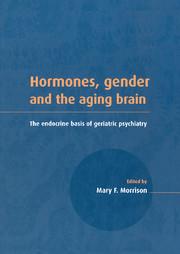Book contents
- Frontmatter
- Contents
- List of contributors
- Preface
- Acknowledgments
- Part I Overview
- Part II Hormones and mental health in the elderly
- Part III Effects of hormones and behavior on immune function
- 13 Estrogens, stress, and psychoneuroimmunology in women over the lifespan
- 14 Gender differences in immune function at the cellular level
- Part IV Hormones and gender differences in psychotropic drug metabolism
- Index
13 - Estrogens, stress, and psychoneuroimmunology in women over the lifespan
from Part III - Effects of hormones and behavior on immune function
Published online by Cambridge University Press: 18 September 2009
- Frontmatter
- Contents
- List of contributors
- Preface
- Acknowledgments
- Part I Overview
- Part II Hormones and mental health in the elderly
- Part III Effects of hormones and behavior on immune function
- 13 Estrogens, stress, and psychoneuroimmunology in women over the lifespan
- 14 Gender differences in immune function at the cellular level
- Part IV Hormones and gender differences in psychotropic drug metabolism
- Index
Summary
Stress, sex hormones, and psychoneuroimmunology
Studies of relationships among the central nervous system (CNS), the immune system, and the endocrine system have shown that the systems interact through multiple pathways. The ‘stress’ hormones have received the greatest attention in the neuroimmunology literature, particularly cortisol and the catecholamines; sex hormones have not been studied as intensively. In this chapter we first briefly review estrogen's immunomodulatory effects. Next we discuss estrogen-related differences in cardiovascular and neuroendocrine reactivity to brief stressors. In the last section we discuss research regarding the effects of estrogen on immune reactivity to stress, and speculate about the possibility that estrogen may moderate hormonal and immunological responses to stress through alterations in sympathetic nervous system reactivity, as well as through regulation of corticotropin-releasing hormone (CRH; Vamvakopoulos & Chrousos, 1993).
Estrogen and immune function
Estrogens, androgens, and progestogens can serve as regulators of immune function; in turn, the circulating levels of these hormones can be modulated by the immune system. Many of these interactions between the immune system and gonadal steroids appear to be mediated through feedback loops in the hypothalamic–pituitary–gonadal–thymic axis, with thymic factors playing a key role (Erbach & Bahr, 1991; Grossman, 1985).
- Type
- Chapter
- Information
- Hormones, Gender and the Aging BrainThe Endocrine Basis of Geriatric Psychiatry, pp. 289 - 301Publisher: Cambridge University PressPrint publication year: 2000



